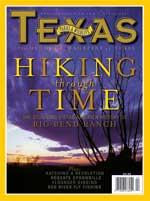
Protecting Seagrass
New regulation prohibits seagrass destruction in 50-square-mile area.
By Aaron Reed
Starting May 1, the TPWD will be asking boaters to take a different, more conservation-minded tack when running the shallow, productive grass flats near Rockport and Aransas Pass.
On that date, a new regulation prohibiting the destruction or uprooting of seagrasses will go into effect in the 32,000-acre Redfish Bay State Scientific Area. The 50-square-mile area is bounded by the Gulf Intracoastal Waterway to the west, the Corpus Christi Ship Channel to the south and the Lydia Ann Channel and Aransas Bay to the east.
The more than 10,000 acres of seagrass meadows in the area — primarily turtle grass and shoal grass — comprise the northernmost extensive stand of submerged marine grasses in Texas. The same area consistently provides the highest catch rate of red drum on the entire Texas coast in Coastal Fisheries gill net samples.
“Is that related to seagrass? Absolutely,” says Dennis Pridgen, a TPWD coastal fisheries biologist.
“A seagrass meadow supplies everything that many marine organisms need. It provides food for grazing animals at the base of the food chain, surfaces to cling on for small crawling critters, shelter and hiding places for small invertebrates and fish, and ambush points for the larger predators and game fish,” he says. “For them it’s the nursery, the roof over their heads and the grocery store all rolled into one.”
Seagrass meadows are dynamic places that change in size and composition for a number of reasons. Some of those are naturally occurring. For instance, late summer drift algae mats can shade an area and kill off patches of grass, revealing bare sand or mud — locally called “potholes.”
One change that is not natural, and that the new seagrass regulation is aimed at reducing, is propeller scarring.
“The nature of the boats that are being used on the coast now — high-performance, tunnel-drive, shallow-draft boats — allow people to operate in shallow areas where in the past they were not able to run a boat,” Pridgen says. “A high-horsepower motor produces enough torque that even when the prop is digging into the bottom, the engine can still propel the craft at planning speeds. That creates what we call a prop scar.”
There is clear evidence that prop scars can reduce the productivity of the ecosystem. When propellers cut through the bottom, they destroy the roots of the seagrasses, and it can take years for the scars to heal, particularly in turtle grass beds. Some prop scars channel currents and can become many times wider and deeper than they initially were.
Thousands of prop scars can be found in the area. A recent TPWD study found that, in Redfish Bay, over half of the seagrass sites examined had prop scars. The northern half of Redfish Bay — the popular Terminal Flats and Middle Grounds, along with Estes Flats — appeared to be most heavily impacted, Pridgen says.
The new regulation makes it a Class C misdemeanor to destroy or uproot seagrasses and replaces a voluntary “no prop” zone in part of the area. The approach was chosen by the TPW Commission in November 2005 as an alternative to mandatory no-propeller zones.
Lt. Alan Teague, a game warden in the Corpus Christi regional office, says the area’s 30 game wardens will phase in enforcement of the regulation.
“It’s going to be heavy on the education part,” Teague says. “Obviously, if there is a blatant violation, it will be addressed appropriately. But like any other law, we want people to be aware of it. A violation that occurs as a lack of knowledge isn’t the same as something that is done out of wanton disregard.”
By the time the regulation goes into effect May 1, TPWD employees hope to have signs up at area boat ramps and a substantial number of boundary markers in place around Redfish Bay, particularly at popular entrances to the flats such as Yucca Cut and Corpus Christi Bayou. A later phase of the project will include marked “run” lanes.
Boaters and anglers will have brochures, maps and other materials to help them learn how to avoid damaging seagrasses.
“Of the management options available to us, this one has the least amount of restriction for all recreational users. There are no closed areas,” Pridgen says. “It does put the responsibility on the user to be aware of water depths and avoid running in areas that are too shallow. When boaters create prop scars, they are damaging valuable habitat that belongs to all Texans. Ultimately that damages the health of the ecosystem and potentially our game fish populations, which is one of the primary reasons we go to the flats to begin with.”

